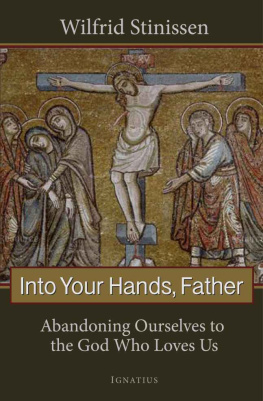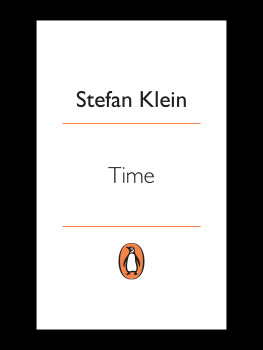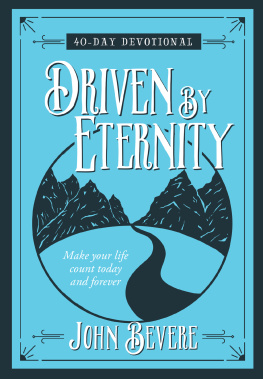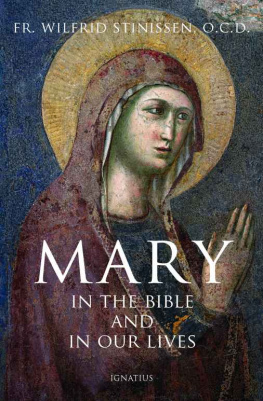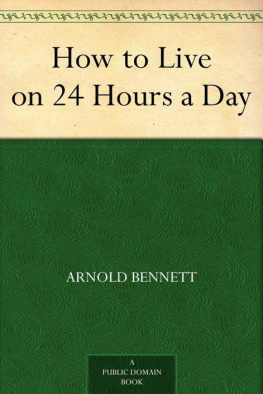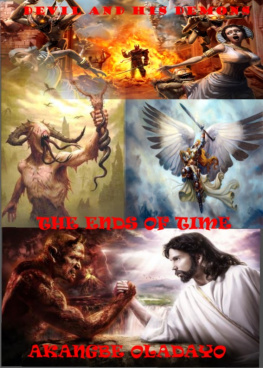ETERNITY IN THE MIDST OF TIME
WILFRID STINISSEN, O.C.D.
Eternity in the
Midst of Time
Translated by
Sister Clare Marie, O.C.D.
IGNATIUS PRESS SAN FRANCISCO
Original Swedish edition:
Evigheten mitt i tiden
1992 Libris, rebro
Unless otherwise indicated, Scripture quotations are from Revised Standard Version of the BibleSecond Catholic Edition (Ignatius Edition) copyright 2006 National Council of the Churches of Christ in the United States of America. All rights reserved worldwide.
Cover art:
Cupola of Genesis (composite photograph)
View of the dome with the Creation
Photo credit: Cameraphoto Arte, Venice/Art Resource and
Close up of the center
Photo credit: Alfredo Dagli Orti/Art Resource, New York
Mosaic of the narthex,
Venetian Masters, ca. 1230
San Marco, Venice, Italy
Cover design by Enrique J. Aguilar
2018
All rights reserved
ISBN 978-1-64229-062-2 (EB)
ISBN 978-1-62164-280-0 (PB)
Library of Congress Control Number 2018961114
Printed in the United States of America
Preface
We think we know what time is. For as long as we have existed we have lived in it. We are familiar with time. Time is our home. We cannot imagine how it would feel to find ourselves outside of it.
Is it not strange that something as ordinary as time is so mysterious? As soon as we begin to go deeper into the essence of time, we find ourselves face to face with a mystery.
For many, it is surely rather annoying not to be able to understand something as simple as time. For myself, I prefer to rejoice in the fact that everything around us is so great and mysterious that we can live in eternal wonder and always philosophize more. We are like children in a land of fairy tales where everything is exciting and exploration never ends.
The intention of this book is not to explain what time is and thus take away its mystery. Instead, I would like to begin with admitting that the simple reality of time surpasses my ability to understand it. My aim is to focus on time, to see it from different perspectives, to discover how rich and many faceted it is. Rather than take away its mystery, which would be arrogance, Iwould like to show that time is even more mysterious than we had imagined. Above all, I would like to examine how we should live in time and how we can make use of the tremendous possibilities that time offers to us.
1
The Riddle of Time
There can be a tendency to imagine time as something absolute, that there is a time that is valid for the entire universe. We associate it with the image of a ticking clock, of running water, or of sand; this time is the same for everyone; it lives its own life; it continues inexorably and independently of what we desire or do. We cannot prevent time from passing. It pays no heed to us.
Objective and Subjective Time
In reality, there is no absolute time. Time always has to do with something else: an event, a state of being, an action, a meeting. Aristotles (384322 B.C.) ingenious definition of time as a measure of movement joins the concepts of time and movement. Without movement, there is no time.
If we remain on earth, there is a time that we can call objective time. That is the quantitative time that we read on our clocks and to which we must adapt if we want to live in harmony with one another. This time, which is dependent on the turning and rotation of the earth, may not be underestimated. How could we have encounters with each other if there were not a universally valid time?
Still, it is not the quantitative time that is the most interesting, nor is that the time we will primarily be considering here. What interests us is subjective, psychological, experienced time.
The expression subjective time can perhaps awaken unpleasant feelings. Shall we really focus on analyzing subjective impressions and experiences? Would it not be better to keep to objective reality? Surely it would, but we must not confuse objective with objectivistic. Philosophers have often had the tendency to think objectivistically; that reality is just what it is, independent of man. The ideal for the philosopher is to be an observer, to remain neutral, without interfering in realitys way of being. This leads, consequently, to a mechanical philosophy, to a reality that is like a machine. Let us see what this machine produces.
This kind of philosophy is uninteresting. Philosophy is only exciting when it helps us to live. It is always life that is primary and most important. All that does not contribute to our living a richer, more genuine life is worthless.
Reality Exists Thanks to Man
What does reality mean for me? Do I have a place in reality, and if so where? What is my purpose in reality? It is questions like these that philosophers worth their name ought to answer.The philosopher is not separated from the reality he is studying. He is a part of it; he influences it, enriches it, and gives it a new meaning.
While in the past, positive science was seen as the ideal for objectivity, the new physics shows that such an objectivity does not exist, that it is even, in principle, impossible. In quantum physics there is no sharp distinction between the one who observes and what is observed. The electron is either a wave or a particle, depending on how one places his instruments.
When I look up the definition of the word mountain in my dictionary, I find: a natural elevation of the earths surface. That is a typically objectivistic way of seeing it. In reality, a mountain is much more than a natural elevation of the earths surface. A mountain is something you can climb, a place where you breathe cleaner air, where you feel a little closer to heaven,where you can pray better...
A stream is more than a flow of water in a channel or bed. We get our drinking water from a stream. You can swim and bathe in a stream; you can lie on its shore and sunbathe; you can sit and meditate on the shortness of life. Thanks to the human person, this stream has a meaning that it could not have had before the arrival of man. It is these meanings that make the stream important for us, and, more than that, they allow the stream to exist and form its essence.Without man, the stream is only matterone is tempted to say dead matter, but we can hardly say this now in the era of new physics, since the border between life and non-life is more and more blurredbut when a person comes in contact with the stream, it becomes filled with meaning, sense, and spirit. It is precisely this meaning, this spirit that is the substance of a thing. It is the Spirit that gives life, the flesh is of no avail (Jn 6:63).
I do not think it is too presumptuous to quote these words here. Jesus said them just when he had openly spoken about the Eucharist. The disciples were astonished and did not understand how the bread that he would give them could be his Flesh. Nor has the Reformation been able to understand how the Catholic Church can speak of transubstantiation. How can one claim that the Eucharistic bread has been transformed into the Body of Christ when any scientist can prove that the bread has the same chemical makeup after the Consecration as it had before?Nothing has changed chemically. How then can the breads substancehave become the substance of Christs Body? But the substance of things is not their chemical makeup. Rather, it is now the true Bread, the living Bread, the Body of Christ, that nourishes the divine life within us.
The Talents of Time
The purpose of this long digression was to show that subjective, experienced time is not a less important time. It is rather the objective, neutral time that is less important. Apart from the human person, reality is an incomplete symphony.
Next page

